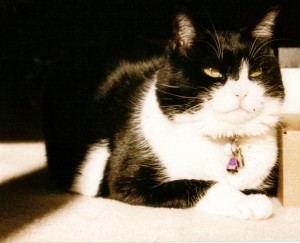by Nancy E. Hassel, LIPetPlace.com
Long Island happens to be home to thousands of feral cats – and this winter has been a tough one for many colonies across LI. Many of these cats and kittens are cared daily for by devoted volunteers of rescue groups that try to help deter the problem by trapping them, spay and neutering them and re-releasing them back into the colony their were trapped at. This is also know as Trap-Neuter-Return or TNR. There are exceptions that some younger cats or kittens that are not quite as feral and can be rehabilitated back into living in a home, are giving the chance to be put up for adoption.
Some may wonder where do all these cats come from? Why do we have such a problem with feral cats across our Island? Some contributing factors are people have the false information that cats can fend for themselves and dump cats they no longer want, or were not supposed to own if they were living in an apartment complex or college dormitory. Domesticated cats do not do well when abandoned, and many die from getting diseases that they were not exposed to before, get hit by cars or attacked by other animals. Other factors are people that have or live near a colony of feral cats and just feed them and never ask for help to have them spayed or neutered or know about rescue groups that offer low cost spay and neutering – and as nature would have it, kittens keep coming. I personally remember one house in Lindenhurst while taking my niece and nephew trick or treating a few years ago, there had to be at least 50 cats and kittens living around this house. The word was the owner of the house was feeding the cats continually but not doing anything about the overpopulation. This was in a neighborhood of close quarters and those cats were all over the neighborhood. It was quite sad as the cats were very feral.
Interestingly many of our college campuses have a feral cat problem as well. Stony Brook University actually has a program called SBU Cat Network in which faculty and students volunteer in to help the cats living on the University’s campus. In 2002, Associate Professor of Psychology, Dr. Nancy Franklin founded the program based on Stamford University’s model on how college campuses deal with feral cat colonies. The SBU, is solely dedicated to helping the cats on their campus, and is not an animal shelter. They do offer advice to people and other rescue groups about feral cats, but say that Stony Brook is not a dumping ground for cats, and they cannot take in unwanted cats.
Since the inception of SBU, they have rescued about 350 cats in which half were placed in homes and half were trapped, spay or neutered and released back to their colony. The campus currently has about 30 colonies on the grounds and each colony has an insulated shelter the cats can go into for warmth and to get away from inclement weather. The volunteer students and faculty feed the feral cats 365 days a year and also participate in fundraising for the group and TNR. And as with many other rescue groups raising funds is a challenge in this economy and our currently running in the Shelter Challenge.
Many of the cats that end up as part of a feral colony on the campus are a direct result of some students keep them illegally in dorms and then letting them go when the year is over. As part of the SBU Cat Project outreach, student volunteers do try to educate other students that dumping cats on campus is neither acceptable nor humane – and let them know they are not allowed to keep pets on campus. There are about 25 very active student volunteers in the program, 10 faculty volunteers and many other volunteers throughout the campus. Franklin said, “The University has been very gracious to us while we have been running this program and our volunteer students and faculty members have been wonderful.”
Another organization which serves the towns of Riverhead and Southold is SAVES (Spay, Alter, Vaccinate, Every Stray) a 501 c 3 all volunteer non for profit organization. Like SBU they have no shelter to house cats or kittens, but do have limited foster homes for feral cats that are suitable for homes (that become domesticated). SAVES main focus is TNR, care for the feral cat colonies in both towns – in which there are approximately 40 colonies with a total of about 500 cats. SAVES provides food, winterized shelters, medical attention (besides spaying and neutering) and have volunteers go to feed and check on the colonies daily.
The winterized shelters were originally provided by Shoreham Wading River High School, teacher Dave Driscoll, who and now is at Shoreham Wading River Middle School. Mr. Driscoll wants to work with SAVES to offer humane educational programs, and to help motivate the students to build new shelters. The winterized colonies are now built by a family of SAVES volunteers, but could use additional help in the building process. There are singular shelters and multiple cat shelters made with openings sized for cats to go in and out of, but not big enough for raccoons to get it, the shelters are also up off the ground to help protect the cats from bad weather.
SAVES President Al LaFrance said, “We get about 40 phone calls a week from people who need help with feral cats on their property or looking to re-home cats. We help people living in our territory with TNR, but do not have the resources to help with re-homing.”
SAVES has been going to Kent Animal Shelter for low cost spay and neuter for a while and in 2010 had about 250 spayed and neutered there and had approximately 600 cats spayed and neutered for the entire year about 96 of which were done for free by Helping Paw (a mobile unit) that came to Riverhead to help them. Others were spayed and neutered at the North Folk Animal Hospital and Mattituck Laurel Animal hospital – who they also go to for medical care for the cats.
Their main outlet for adoptions is at the Riverhead Petco in which they house cats and kittens available for adoption through SAVES. Volunteers go Petco 7-days a week 2-times a day to care for them and this past year they have adopted 177 cats. There is an application process that potential adopters must fill out and be approved, as SAVES is looking for permanent homes for their cats with proper care. SAVES is opposed to de-clawing and adopts cats out that will live indoors only.
The focus for them for 2011 is to have more feral cats spayed and neutered by continuing with working with Kent Animal Shelter and their other veterinarian partners, and set up free clinics with Helping Paw. They also plan to offer more humane educations programs and presentations for schools, and boy and girl-scout groups.
So what can you do to help? If you see a feral cat colony that no one is caring for, i.e. no shelter provided, no food or water provided and kittens continually being born, contact a local animal rescue group to let them know about it. (See below for list). If you have feral cats, and are just feeding them, you are very well adding to the problem – reach out to the public animal rescues for help with feral cats in your yard, facility or business.
Another way you can help is by making a monetary donation or donate much needed cat food to help the cats make it through the winter. If you are a cat lover, think about fostering a kitten or two to help them find new homes. Feral cats can very well become the best cat you may ever have had-they don’t all stay in the feral state into which they were born into. I speak from personal experience, taking in a feral kitten from the age of 3-months, who lived a very spoiled 16-years and was a very sweet, smart, funny and dog adoring cat. And yes, her name was “Kitty!”
All About Spay and Neuter – A full service TNR 501 c 3 non-profit all volunteer organization that does 100% TNR servicing Brooklyn, Queens, Nassau and Suffolk. They are not a shelter but can be called for help if you have a feral cat problem in your area. They do about 90 TNR’s a month and since their inception in 2004 have helped just over 5,100 feral cats of which about 850 have been adopted into loving homes.
Kent Animal Shelter – Has low cost spay and neuter.
SAVES Inc. – See above.



Categories
Archives
Blogroll
Meta